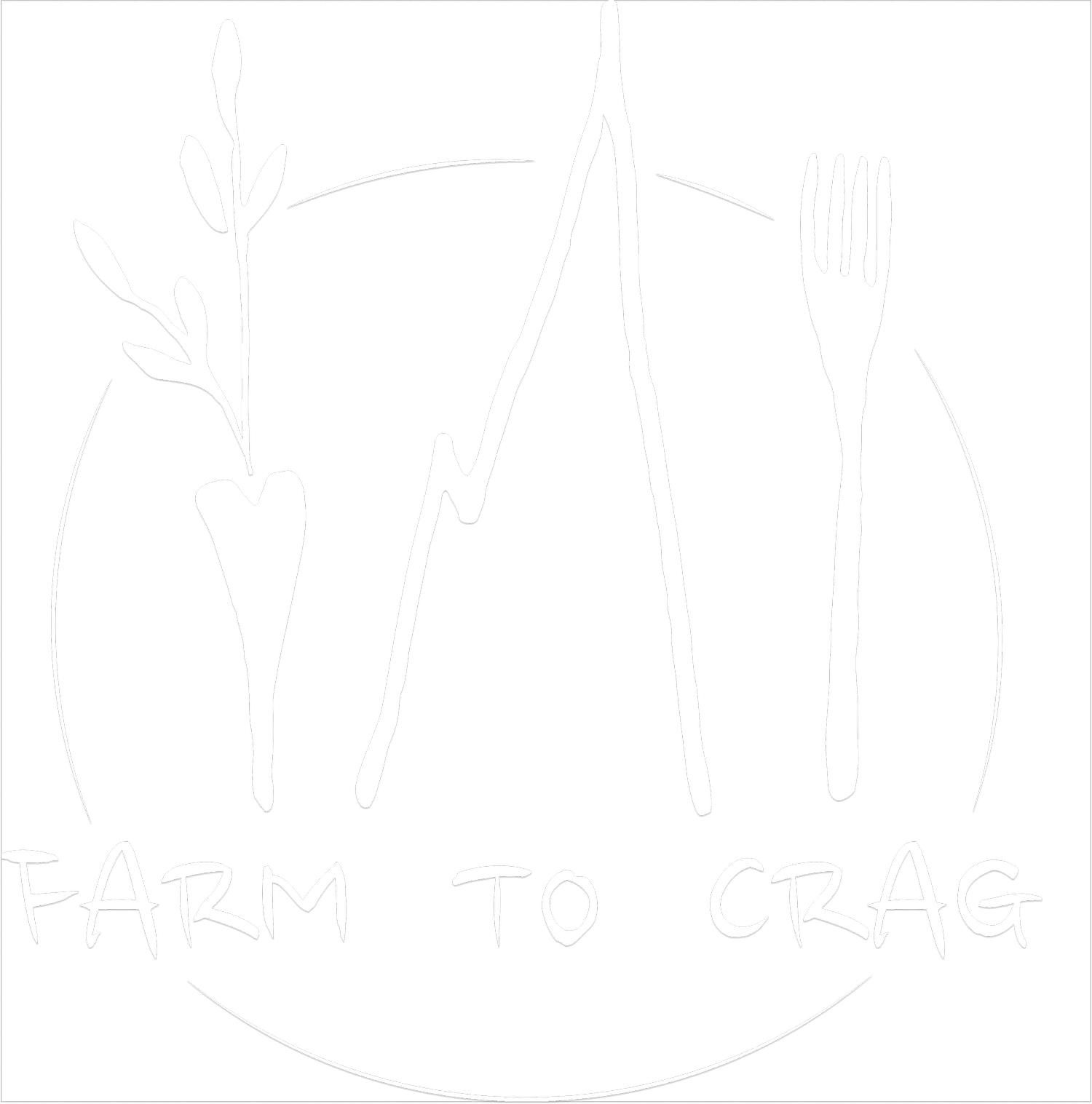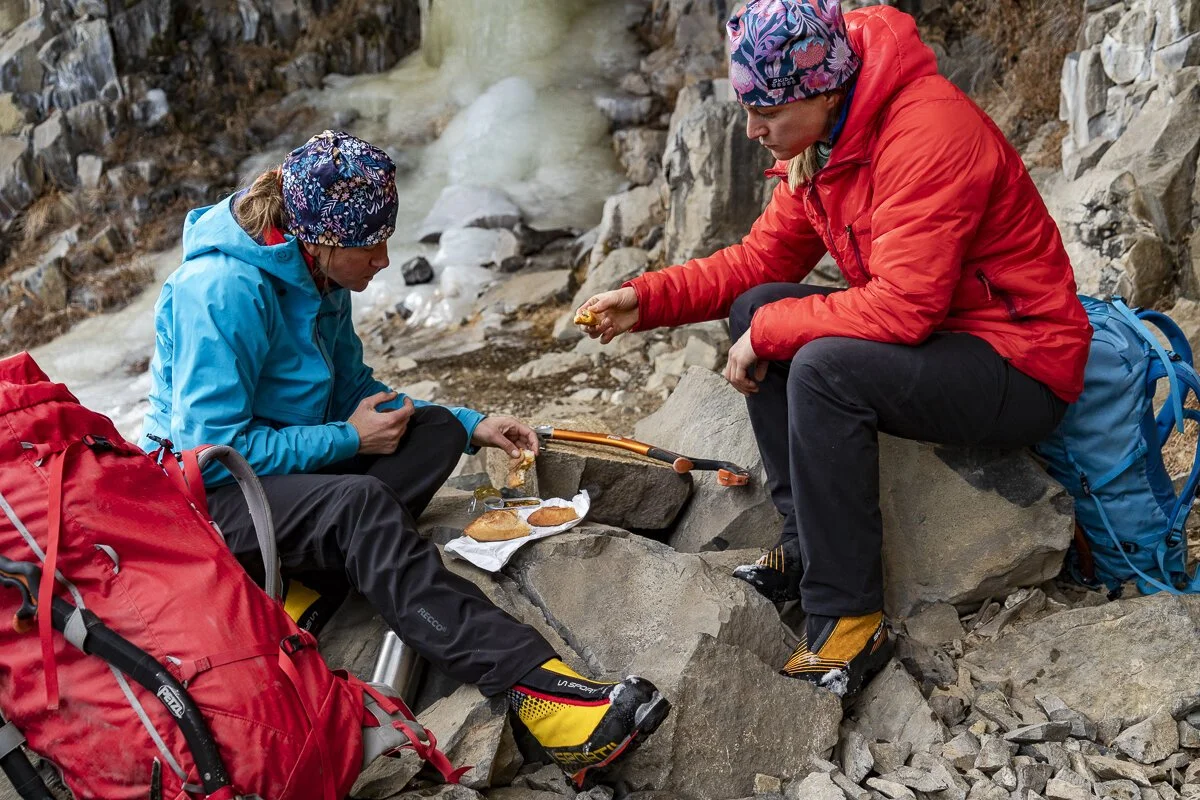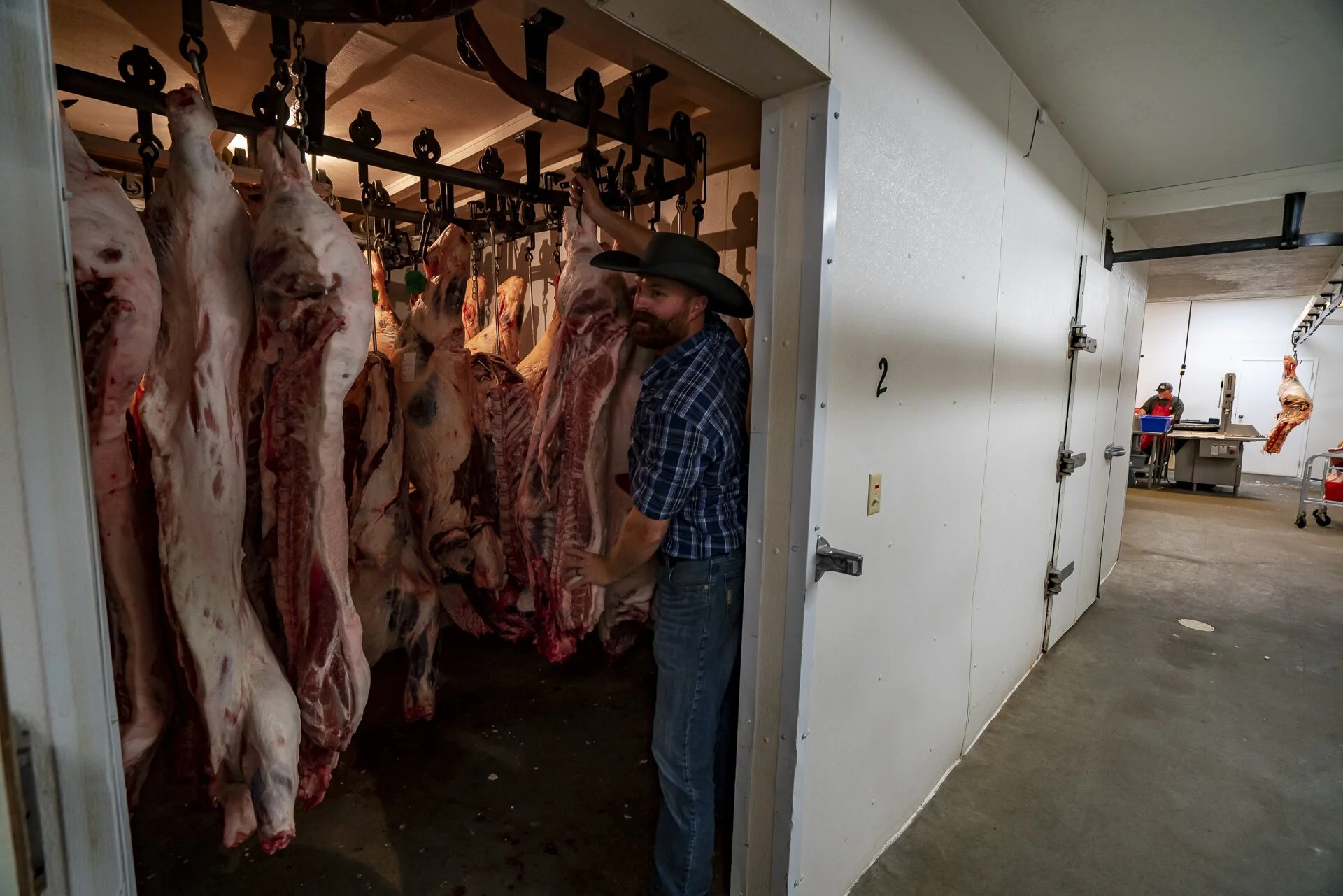Montana Homegrown
A deep exploration in to how small food processors are building a more resilient Montana food system
This winter I spent a day ice climbing in Hyalite Canyon with my dear friends Kate Rutherford and Anne Gilbert Chase, Farm to Crag founder and board member, respectively. Between laps on the Scepter, we talked about food, snacked on dried fruit and jerky, and reveled in the wintry beauty. And while we all tend veggie gardens in summer and buy local, there’s more needed to support healthy food systems.
This story, originally published last summer and updated for Farm To Crag, shows how in addition to the small farms and ranches and markets, local food systems need infrastructure. The lack of small food processors is one bottleneck common around the country.
Eating real food and talking about food systems during a snack break at Montana’s Hyalite Canyon. Photo - Jason Thompson
Tim Anthony walked behind a small group of black Irish Dexter cows, moving them along a fence line to new pasture above Black Dog Farm, just outside of Livingston, Montana. Slowly, he navigated a steep spot around a juniper, wading through the already-drying grass. It was early July, and snow still hung on in the high cirques of the northern Absaroka Range to the southeast.
In the gulch below, 500 layer hens chattered and clucked as they milled around the roost and the neighboring pasture. A pair of white Italian Maremma guard dogs swirled through the birds and back to Anthony’s wife, Kira Jarosz, at the farm headquarters. Mug of afternoon coffee in hand, Jarosz was talking to a plumber about the faucets he was installing in the farm’s new poultry processing facility.
“I have one more question, but I didn’t want to bother you,” the plumber said.
“You’re not bothering me,” she said, following him into the Tyvek-wrapped 350-square-foot building. “The most important thing we’ve got going on right now is trying to get this thing ready to go.”
When Anthony, 34, and Jarosz, 31, bought this 35-acre parcel in 2016, Jarosz was still finishing vet school in Oregon, so Anthony, a welder and Iraq War veteran, moved out a month ahead of Jarosz with a trailer of pigs, chickens, goats and dogs. They spent the following year getting the farm up and running, while simultaneously hauling rundown equipment and garbage off the property, which had been used as a dairy, sawmill and junkyard.
Tim Anthony and Kira Jarosz photographed at Black Dog Farm in Livingston in May, 2020. Photo - Tori Pintar
Other than supplying meat and eggs to Little Star Diner in Bozeman, the farm now sells exclusively to individuals. After the coronavirus reached Montana in mid-March of last year, Black Dog switched from selling mainly at year-round farmers markets to an online store offering weekly home deliveries in Livingston and Bozeman, and community supported agriculture shares. Soon, they were so busy Jarosz had to cut her days at the vet clinic in Livingston from three a week to one. Demand continued into the summer, with about 450 pounds of pork and 100 dozen eggs going out the door weekly.
Until 2020, they had taken their meat birds four and a half hours to the Montana Poultry Growers Co-op in Hamilton, which had been the state’s only poultry processing facility aside from the Hutterite colonies, which don’t process birds for other farms. Counting drive time, processing and waiting for the meat to freeze for transport per state regulation, it was a 48-hour round-trip. When they found out the co-op couldn’t process the 2,000 birds they planned to raise in 2020, they fast-tracked their own five-year-plan to build a processor themselves.
Jarosz applied for grants and then, by happenstance, they met someone who agreed to provide a private loan. When the shutdown began and they transitioned to the online ordering system, their chicken and pork pre-orders shot up. Because they knew they’d have the processing facility, they went from planning to process 2,000 chickens to about 3,500.
As of summer 2021, they’d received funding from state and nonprofit-funded grants to help with the cost of construction and equipment, as well as through a Montana Department of Agriculture’s Montana Meat Processing Infrastructure Grant. Designed for small and medium-size meat processors responding to the COVID-19 crisis by expanding infrastructure and capacity, the grant program received nearly 150 applications requesting a total of almost $18 million. While only $2 million was originally designated for the program, the department was able to secure and allocate $7.5 million to more than 60 processors.
“Investing in meat processing infrastructure will help our Montana producers, strengthen local food systems, and bolster food security for Montanans in communities across the state from Plains to Circle,” said then-Gov. Steve Bullock in a press release about the grants.
Because the new facility meets all state and federal guidelines, the potential exists to process birds for other farms in the future. Under state law they can process up to 20,000 a year. On Saturday, July 18, 2020, Jarosz, Anthony and three farm hands processed their first 150.
A year later, Jarosz is now full time at the farm. With total control over when to process every single bird (instead of being tied to a processing date made elsewhere, months in advance), she is happier with their product. Their Whole Chicken CSA has more members signed up than they’ve ever had, and they’re planning to add pieced chicken to their offerings.
***
With empty grocery meat freezers and flour shelves still echoing in the collective consciousness, reconsidering the system that produces America’s cheap food has become a topic of conversation nationwide, including in Montana. Consumers want more secure food, and they’re looking local, with small producers and processors seeing increased demand. In one example, Wheat Montana had to limit the amount of flour individuals could purchase at one time, while interest in regionally milled flour surged around the country.
Eating local food seems like it should be easy for Montanans, since the state’s $4 to $5 billion agricultural economy produces more food than one million residents could consume. But most of that economy’s commodity crops — beef, wheat, barley, safflower, lentils and chickpeas — get exported to large out-of-state plants to be processed, and today only 10% of the food Montanans eat is produced here, as compared to 70% in the 1950s.
“Montana and American farmers have become good at producing cheap food commodities for the world, but ironically the COVID-19 crisis demonstrates we struggle to feed ourselves,” wrote Walter Schweitzer, president of Montana Farmers Union, in an op-ed for the Bozeman Daily Chronicle.
As late as 1970, every major town in Montana had a meatpacking plant and a flour mill and a bakery, Schweitzer said in a phone call, explaining that federal policies favoring large corporate farms and centralized processing facilities have made it hard for such small operators to survive.
“The most glaring example right now is the meat processing industry, but it’s true for bread, cereal, pulse crops — anything that needs to be processed before it’s eaten has the same problem.”
To keep more Montana-grown food — and the associated dollars — in-state, the local supply chain needs to expand. That means distribution and storage infrastructure, but mostly the bottleneck is at the food processor level.
“If we want to have good food safety, food security, wages, childcare and all those things you need to have a life, there needs to be more [food processing] infrastructure,” said Julie Foster, director of the Ravalli County Food and Agriculture Development Center, one of eight state-supported nonprofit centers that work to increase value-added production in Montana.
But because local food chains aren’t subsidized the way the larger system is, prices are higher. Plus, with its low population and poverty rate of 15%, Montana’s market for local products is relatively small.
***
When Brian Engle started Pioneer Meats in Big Timber in 2004, his wife Kary supported their family with her job while he maxed out two credit cards and spent their savings to build the company’s first 10-by-100-foot shop. Later, a grant and a loan from the state helped Engle kick-start his sausage line.
Pioneer is now one of five USDA-inspected meat processors in Montana, meaning meat processed there can be shipped out of state. But since earning the licensure in 2019, there’s been so much in-state demand that Pioneer hasn’t exported a single pound of meat, Engle said. In the first six months of the pandemic, the facility in Big Timber went from slaughtering and processing 25 cattle a week to 38 and hired four new employees, bringing its roster to 28. As of April 2021, they’re looking to hire more additional employees after expanding to a new retail area in downtown Big Timber, Meats of Montana, which Engle plans to open in May. The project was a $466,000 expansion that included adding 1,000 square feet of freezer space to his 12,000-square-foot facility and purchasing an existing facility. In addition to the new retail space, he plans to dedicate a section of the building to processing wild game. He, too, received funding from the state’s meat processor grants.
“If you were to ask, ‘Why [are] there not more small plants?’ the answer would be it takes a lot of money,” Engle said. “If you don’t start out with a million dollars, you won’t get anywhere. And that’s a big chunk of change to come up with if you’re trying to just get started, because you have to pay that back.”
Still, people are finding ways to make it happen. Since 2014, Root Cellar Foods in Belgrade has processed locally and regionally grown vegetables for wholesale buyers including restaurants, schools and Montana State University. The only facility of its kind in the state, Root Cellar basically had to create its own market.
“A lot of people didn’t know they needed it,” said owner Christina Angell. “It was hard to get into the game. ... Our hope was that we’d be able to take the guesswork out of people getting a carrot — they [aren’t] used to seeing the way local carrots are, and don’t know what to do with them — and create a finished product that their cooks could use in the kitchen.”
There’s only so much you can charge for vegetables, and the business always had thin operating margins. When Angell lost almost all of her wholesale accounts as the economy closed down, she pivoted to an online farmers market.
“I probably would have had to shut down if not for that retail market,” she said, standing by an industrial-sized greens washer she bought with help from state grant funding.
Now a year later, wholesale is around 50% of Angell’s business. She originally figured she’d have to downsize to a different space with a large pivot to retail, but she’s been surprised.
“It’s been nuts—in a really positive and good way,” Angell said in April of 2021, a year after this story was first published. “The market took off, and it has been remarkably good for Root Cellar. The retail market is really what’s keeping this business alive.”
Her retail margins are much higher than wholesale, and she says the customers are much more appreciative.
“People know you’re getting good local food and it's worth it, and they’re willing to pay for it. Versus with wholesale, I'm competing against a Sysco carrot.”
***
In the Flathead Valley, Kalispell Kreamery started its own processing facility 10 years ago out of necessity, said co-owner Jared Tuck. To keep costs manageable, Tuck and his family chose to forgo organic certification, which would have pushed prices up for consumers as well. At the time, it was hard to find and afford the right equipment for a small operation.
“Most of the equipment is manufactured, designed and priced for large production — tens of thousands of gallons a day, whereas we’re looking at 1,000 gallons a day,” Tuck said.
In addition to bank-financed loans, the family applied for state and federal grants to establish the creamery, and bought some used equipment. It was the only way they could find to stay on the farm.
“We were shipping our raw milk to Bozeman, 300 miles, to have a market for it,” Tuck said, explaining that the family had been milking cows for 30-plus years before opening the creamery. “As dairy started to disappear from our area, the processors were less likely to send a truck out for our milk. We either had to get out or find a different route.”
Amsterdam Meat Shop owner Jake Feddes: “Processing meat is a community service, is the way I look at it. I couldn’t even take a paycheck at what we were making on custom processing.” Photo - Jason Thompson / MTFP
A 300-pound cow hindquarter hung from a trolley in the processing room at Amsterdam Meat Shop at 7:30 on a Thursday morning last July. A man in his 20s cut chunks off the quarter with a handsaw and walked them over to two others, around the same age, working at a counter. One of them removed bones with a knife and set aside the more valuable cuts. He pushed the trim meat to the man beside him, who put it in a Hobart chopper.
Started in 1949, the shop in Amsterdam operated as a custom butcher for most of its existence, meaning ranchers could process animals for their own consumption there, but neither they nor the shop could sell retail. Harrison rancher Jenny Kahrl bought it in 2014 to have a place to process her cattle, and during the six years she owned it, Kahrl improved and expanded the kill floor, added a large cooler, and earned state licensure allowing the shop to sell retail to individuals and restaurants, and process for others doing the same.
Kahrl sold the shop to Manhattan rancher Jake Feddes and his family on July 1, 2020, and they’ve continued slaughtering and butchering cows, hogs, bison, sheep and other animals for area producers including Black Dog Farm, as well as selling their own Red Angus to retail customers. Even though the pandemic has increased demand so much that slaughter dates are booked a year in advance, the revenue from processing really just keeps the lights on, said Feddes, 38.
“Processing meat is a community service, is the way I look at it,” said Feddes, 37. “I couldn’t even take a paycheck at what we were making on custom processing.”
To increase revenue, Feddes added a dedicated retail space and coolers, and started posting on Facebook, whereas, he said, Karhl had never promoted consumer sales. Demand for in-house products went from $50 a week in February 2020 to $1,000 a day that July. Amsterdam also received a state meat processor grant, which Feddes used for equipment purchases and facility modifications to increase cold storage and processing capacity. With the added equipment, he’s increased processing volume by 50%, and is now up to 14 employees, double what Karhl operated with.
At some point, he aims to open a storefront in Bozeman selling custom cuts of local meat.
“My ultimate goal is for me to be able to make a living operating this place, and to keep it alive so people have a place to take their animals,” said Feddes. “[I want to] pay my employees a living wage in the Gallatin Valley, and provide for my family.”
Jake, Ella and Alysa Feddes in the retail shop at Feddes Family Meats, aka Amsterdam Meats, in Amsterdam, Montana. Photo - Jason Thompson
With increased demand during the pandemic and markets growing as more people move to Montana from larger cities, it’s a crux moment for alternative food systems in Montana.
“This is the window of opportunity,” said Jeff Schahczenski, an agricultural and natural resource economist who’s worked at the National Center for Appropriate Technology in Butte for 16 years. “This is the chance to say, ‘You know, we have examples of how this can be done, and we need to do more of it and support that through public policy, more than the same old. More than go back to the status quo.”
***
Part 2 of Homegrown will explore how community-driven food processors are acting as a bridge to a more resilient Montana food system. This story originally ran in Montana Free Press; a nonprofit watchdog site founded in 2016, it's gaining traction in Montana, as well as national support. There's a riveting PBS documentary about the founder, John Adams, in which he loses his job as capital bureau chief for the Great Falls Tribune, moves into his truck, and chases down undisclosed dark money supporting politicians from big business. It's like a climbing dirtbag or trout bum, but a political reporter.




